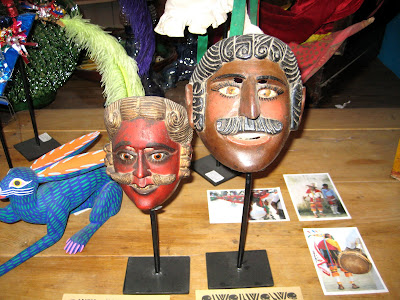 Evita Avery owns La Calaca where you can find the best antique and new folk art. Evita was raised in northern Mexico near Muzquiz in the state of Coahuila on a cattle ranch. As long as she can remember, her mother filled their home with folk art that she had collected all over Mexico. Evita, fluent in English and Spanish, worked at the Museum in San Antonio, Texas in the their folk art department. She has been acquiring and selling folk art for over 26 years. Twenty two years in San Miguel! La Calaca is full of antique pieces, some contemporary pieces and some by the Grand Masters of Mexico.
Evita Avery owns La Calaca where you can find the best antique and new folk art. Evita was raised in northern Mexico near Muzquiz in the state of Coahuila on a cattle ranch. As long as she can remember, her mother filled their home with folk art that she had collected all over Mexico. Evita, fluent in English and Spanish, worked at the Museum in San Antonio, Texas in the their folk art department. She has been acquiring and selling folk art for over 26 years. Twenty two years in San Miguel! La Calaca is full of antique pieces, some contemporary pieces and some by the Grand Masters of Mexico.The old, round lacquered tray is from the state of Michoacan. They have been made in the same village for over 450 years and the older ones were painted with powdered pigments which gives them the most beautiful patina. Laquerware originated in the Orient and it was Bishop Don Vasco who in 1538 organized lacquer guilds which resulted in some of the most outstanding furniture.
 The delicacy of this crowned nun in clay is breath taking. She was made by an artist from the state of Michoacan.
The delicacy of this crowned nun in clay is breath taking. She was made by an artist from the state of Michoacan.
Photosculpture is a technique that started in Mexico City in the 1930's. This technique combines painting, sculpture and photography.

These green angle candelabras are from the remote village of Patamban in the state of Michoacan. This village is also noted for their pinas, pineapple shaped jars used to store both water and tepache (a drink made from pineapple, pulque, water & cloves.)
 This is an "Ex-Voto" or "Milagro Board." These Milagros (miracles in Spanish) are left in churches next to the saint or virgin that one had petitioned in thanks to an answered prayer. This is often done in the Roman Catholic Church along with a candle. For example, the milagro of the cow on the bottom left would have been left in the church because a cow could have been very sick and the farmer might have petitioned to Saint Blaise (patron of sick cattle) for help.
This is an "Ex-Voto" or "Milagro Board." These Milagros (miracles in Spanish) are left in churches next to the saint or virgin that one had petitioned in thanks to an answered prayer. This is often done in the Roman Catholic Church along with a candle. For example, the milagro of the cow on the bottom left would have been left in the church because a cow could have been very sick and the farmer might have petitioned to Saint Blaise (patron of sick cattle) for help.
A colorful collection of antique Guatamalan textiles. Many of them are huipils (traditional blouses.)
 Ceramic papier mache doll forms from the early twentieth century. (I wrote about the papier mache dolls, Lupitas, on July 16)
Ceramic papier mache doll forms from the early twentieth century. (I wrote about the papier mache dolls, Lupitas, on July 16)
 Ceramic papier mache doll forms from the early twentieth century. (I wrote about the papier mache dolls, Lupitas, on July 16)
Ceramic papier mache doll forms from the early twentieth century. (I wrote about the papier mache dolls, Lupitas, on July 16) The papier mache skeleton figures are made by the Linares family from Mexico City. The Linares family has made papier mache figures since the 18th century and are Grand Masters of Mexican folk art.
The papier mache skeleton figures are made by the Linares family from Mexico City. The Linares family has made papier mache figures since the 18th century and are Grand Masters of Mexican folk art.
These Guatemalan masks are so different and I love how Evita has them displayed on the iron stands that she designed and had made right in town. The mask on the left is worn for the "dance of the conquest" and the mask on the right is worn for the "dance of the Mexicans."
 The strikingly, handsome home altar saints are from the nineteenth century. They are articulated so they could be dressed in a variety of clothes.
The strikingly, handsome home altar saints are from the nineteenth century. They are articulated so they could be dressed in a variety of clothes. I am partial to this old dowry chest made out of red cedar. It could have been mine since it has my initials on it!
I am partial to this old dowry chest made out of red cedar. It could have been mine since it has my initials on it!Stop in and say hello to Evita for me. She is a wealth of information on Mexican folk art! Or if you are looking for something in particular, email her at thereallacalacasma@gmail.com
La Calaca
Arte Popular
Mesones 93
San Miguel de Allende
(415) 152 3954
Open: Monday - Saturday
11:00 - 2:00, 4:00 - 6:30

Thanks Robin, I love Folk Art so I enjoyed the blog and photo"s!
ReplyDeleteYou might be interested in my "Artisan & Architecture" tour the end of February. I'll send you the itinerary. It is going to be a great trip.
ReplyDelete